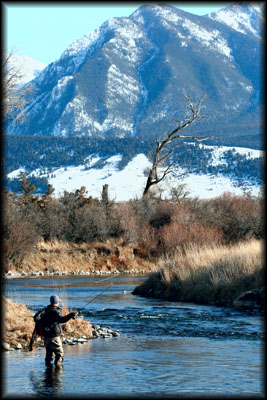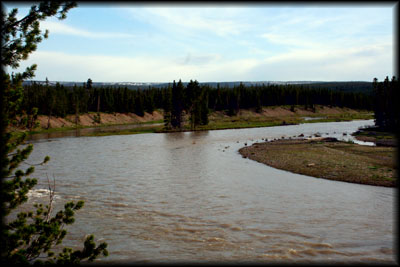
Photography || Portfolio Site || Blog || About || Contact || Home ||
Rivers Love Water: The Good and Bad of a Good Snowpack
Published in the Spring 2010 issue of the Montana Sporting Journal
By Joshua Bergan
A strong snowpack is good for Montana. It keeps our land quenched, our forests (relatively) fire free, and our rivers plump and cold. Regardless of its effects on fishing, an average or better snowpack is a good thing (as long as it's not too well above average).
The common perception is that a good snowpack equals good fishing, but it's not quite that simple. It's not necessarily a dream-come-true for anglers – a good snowpack can create issues, as well as advantages and anomalies, for anglers.
But as with anything else, you take the good with the bad. Sometimes a list helps sort things out...

• Pro, of a good-water year: New bugs. Hatches of bugs of which you've never heard. The white drake? Hecuba? Pale evening dun? You'll likely only find them in good water years. They probably hatch every year, but in my experience, they're more widespread and easier to encounter when the water is healthy and cold.
• Con, of a good-water year: Entire hatches can get swept away during runoff. For example, the upper Yellowstone River lacked its typical midge hatches in the winter of 2008-09 because of the previous spring's deluge. And related to that...
• Pro: Attractors! According to Dan Delekta of Beartooth Fly Fishing on the upper Madison River: “The bug hatches – they kind of overcede everything, and the fish start to eat hard and they start to look for all sorts of different fly patterns – including streamers.” Thus, classic attractor dries should work well. What's more fun than fishing a Coachman, Trude, Stimulator, Wulff, Adams, Humpy, or PMX to eager fish?
• Con: Quicker hatches. You'll get more variety in your bugs, but less duration in their emergences, according to Delekta. “What’s going to happen with the multiple days of temperatures into the 70s and 80s in the valley is that the hatches will start to come off as the water warms and then the warmer temperatures will start the snow melting and the cold water coming into the river will lower the water temperature again and slow down the hatches. So the hatches in this high-water year won’t be as prolific and won’t last as long during the day as they do in the low-water years...It’s not going to be one huge emergence, because the water temperature won’t allow it.”
Incidentally, Beartooth Fly Fishing is a neat shop run by good people – if you're driving on Highway 287 near Cameron, a visit is worth your time.
• Pro: Fat fish. The fish seem noticeably thicker and taller after a few months of strong, cold flows. That said, the fishing won't necessarily be easier. There will potentially be more naturals for our flies to compete with, and a chance that the fish will get gorged and no longer be feeding.
• Con: Wading is tough, so it might be harder to get to those fat fish. Your favorite hole from last year might now be on the other side of a 20-foot-deep trench. Hope you took swimming lessons....

• Pro: Fishable hopper season. In low-snowpack years, many rivers are too low and warm to fish (without harming the trout) by August. Many rivers will be closed to fishing by Montana Fish Wildlife and Parks, either in the afternoon (primetime for terrestrials) or all day. This is avoided with adequate snowmelt.
• Con: Unfishable early season hatches. The two most highly anticipated hatches – Mother's Day caddis and salmonflies – might be completely squelched if the water is chocolate milk and running at 75 miles per hour. Other hatches like golden stones, March browns, and pale morning duns are also threatened, although usually parts of these hatches can escape even extended or early runoffs.
• Pro: Drift boats in late August. When the rivers become warm and low enough to potentially harm trout, they can also potentially harm your hard-sided craft. The rivers get boney and sparse, and even if you're not worried about damage, you'll be getting out to drag the boat over the many scant-water riffles. In good-water years, it's smooth sailing.
• Con: Floating salmonfly hatches can be hairy. Even if the water is clear enough, if the water is high, it can make floating many of Montana's brawling freestones not only a white-knuckled chore, but downright dangerous. Every year, Montana newspapers report at least a couple of fatalities due to wreckless or naïve floaters.
• Pro: New holes. When a strong runoff inundates a riverbed, it has the force to move sand, silt, boulders, trees, cars, etc. When the water level recedes, it often reveals an entirely new river. It might flow through a different channel, or a different side of the same channel. For all intents and purposes, this creates a new river to explore, with new holes, riffles and runs to figure out.
This happens most noticeably on undammed freestones.
• Con: Favorite holes might be gone forever. That hog hole that you relied on for consistently big fish might be totally barren, or might be a foot-deep riffle.
What Mother Nature holds for us is unforeseeable and can change as quickly as the appetite of a Hebgen gulper. Be it easy or tough with thick or thin hatches to savvy, savage or starving fish, it'll be good because it always is, here in Montana.